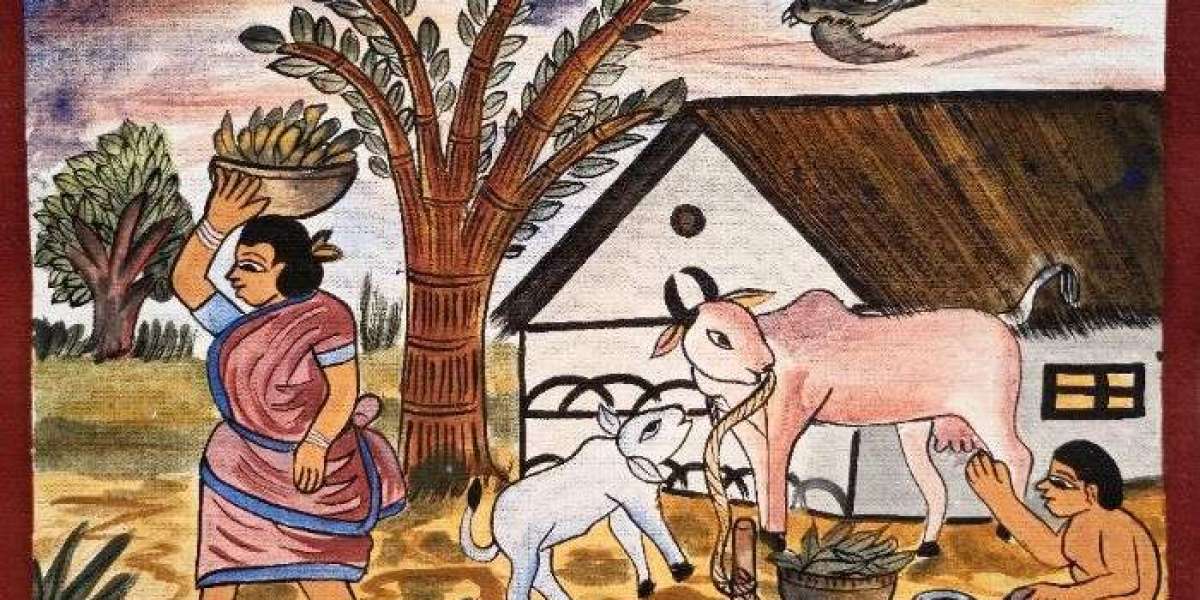Madhubani painting, also known as Mithila painting, originates from the Mithila region in India and holds deep cultural significance. This ancient art form dates back to the seventh century and has traditionally been practiced predominantly by women. It was originally used to adorn the walls and floors of homes during important occasions like weddings, festivals, and religious ceremonies. Over generations, these paintings have been passed down, depicting scenes from daily life, nature, and Hindu mythology.
A Journey Through Time
Paitkar painting is one of the oldest forms of tribal art in India, dating back to pre-Aryan times. These paintings were initially created on scrolls for use in ceremonies and storytelling, rooted in the customs and traditions of the Jharkhandi tribal communities. Each scroll serves as a piece of visual storytelling, preserving cultural history, myths, and legends for future generations.
Paitkar's Craft: Organic Substances and Techniques
What sets Paitkar paintings apart is their profound connection to nature. Artists use colors derived from flowers, leaves, and stones, giving their creations a true earthiness. Brushes made from goat and squirrel hair enable the fine detail that characterizes this style of painting.
Themes and Stylistic Elements
The vivid storylines in Paitkar's paintings are widely recognized. Common themes include scenes from the Ramayana and Mahabharata, depictions of local deities, tribal traditions, and typical village life. The precise line work and vivid colors, primarily red, yellow, and black, captivate viewers with their stylized, emotive forms, transporting them to a historically and emotionally charged environment.
Preserving and Reviving the Tradition
Efforts to preserve and revive Paitkar paintings are ongoing. Workshops and exhibitions help foster this art form, while NGOs and government initiatives support artists, expanding their audience and creating long-term employment opportunities.
Modern Innovations
Today's Paitkar artists are pushing the boundaries of tradition, introducing new themes and experimenting with various media. This vibrant blend of the old and the new has brought Paitkar paintings into homes, galleries, and public spaces beyond Jharkhand.
Respecting a Timeless Tradition
Paitkar painting is more than just an art form; it's a living legacy of Jharkhand's indigenous people. By supporting and appreciating their work, we honor Paitkar artists and their invaluable contributions to India's cultural heritage. Preserving this timeless tradition ensures that the vibrant stories, ideas, and visual appeal of Paitkar paintings will continue to inspire future generations.
In a world that is constantly changing, the enchanting scrolls of Paitkar paintings remind us of the enduring importance of story and art. Let us preserve and protect this priceless heritage to ensure the long-term survival of Jharkhand's dynamic culture.
Conclusion
The vibrant Paitkar painting, a traditional art form of Jharkhand, reflects the region's rich cultural heritage and the resourcefulness of its tribal populace. These scroll paintings, with their organic materials, intricate details, and captivating stories, offer a glimpse into local mythology, customs, and daily life. By increasing awareness, providing financial support to artists, and embracing modern adaptations, we can help sustain this unique art form. Respecting and preserving Paitkar painting keeps a treasured cultural legacy alive and serves as a reminder of the importance of tradition and storytelling in ourrapidly changing world.






